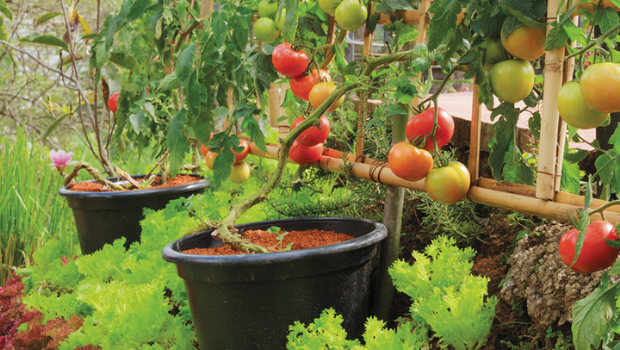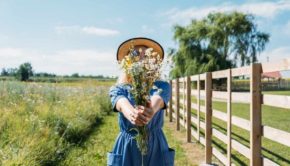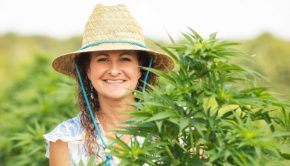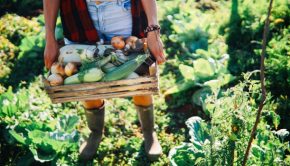Easy Container Gardening: How to Grow Edibles in Pots and Planters
Container gardening offers something for everyone, from beginners to seasoned green thumbs. Growing vegetables, flowers and herbs in pots can be cost-effective, inspiring and tailored for any urban balcony or country patio.
The perks of planting in pots include a reduced risk of disease spreading from one crop to another, fewer critters helping themselves to a free lunch, and less weeding and overall work. For urban garden expert Mark Ridsdill Smith, in Newcastle upon Tyne, England, tending to plants has provided a sense of community. “When I lived in London, I knew almost no one on my street after 10 years, but when I started growing food by the front door, I was constantly chatting to passersby as I tended my tomatoes and squash,” says the author of The Vertical Veg Guide to Container Gardening, who also enjoys the practical side of making connections: swapping seeds, gifting produce and exchanging advice.
Fertile Foundations
Vegetables like lettuce, tomatoes, peppers, eggplant, squash, radishes and beans are ideal for container gardens, and with a little know-how, other crops like watermelon and muskmelon can also thrive. “Many types of vegetables can be grown in pots if they are large enough to accommodate the root system, even potatoes,” says Lisa Hilgenberg, horticulturist at the Chicago Botanic Garden’s four-acre Regenstein Fruit & Vegetable Garden, in Glencoe, Illinois. Choosing pots with the right size and materials is an investment worth making, she notes. “Peppers and tomatoes prefer terra cotta pots. Many herbs thrive when root-bound and do well in smallish pots or grouped together in shallow bowls. Plants needing to climb can be trained to grow on a trellis placed in a container.”
Melinda Myers, the Milwaukee-based author of Small Space Gardening and more than 20 gardening books, encourages gardeners to think outside the box. “Repurposing items is another way to add fun and plantable space. I have seen old teapots, coffee makers, washtubs, coolers and more converted into planters.” For the well-meaning, but sometimes absent-minded gardener, she recommends self-watering pots to reduce maintenance. “These containers have a water reservoir you keep filled. Water moves from the reservoir into the soil, so you need to water less often.”
Generational Nourishment
Using high-quality potting soil is paramount and can be store-bought or made at home for less by combining pH-fostering peat moss, vermiculite and perlite. Plants started from seed are more nourishing for both people and the planet.
“Some seeds thrive most when sown directly in the soil, and cilantro is one of them, as are all root vegetables, as well as beans and peas. Other seeds, like tomato and ground cherry, are best started indoors. Some seeds, like kale and basil, thrive either way,” explains Petra Page-Mann, co-owner of Fruition Seeds, an organic seed company in Naples, New York, that specializes in open-pollinated heirlooms and offers free online tutorials. Seeds can easily be saved for future plantings from crops such as beans, peas, cilantro, dill, sunflower and cosmos. “No one can save seeds better adapted to your garden than you,” she says.
Children are prime candidates for container gardening, especially in cities. Smith muses, “Children get to smell and feel the whole plant—the extraordinary smell of tomato leaves, the bristles on zucchini—and they love getting their hands into the compost. I’ve witnessed children who rarely eat salad demolish a whole tray of fresh pea shoots in minutes!” For young gardeners, he recommends growing “pea shoots, new potatoes (they love digging them up), herbs like mint (to play with and make drinks and potions), alpine strawberries and sorrel.”
Even gardeners with conventional suburban or country plots may find that container crops come in handy. “For those with plenty of garden space, it is a way to bring the garden to your back or front door,” says Myers. “Keeping pots of herbs and veggies close to the house makes harvesting and using fresh herbs and vegetables easier. I have 11 acres, but still use containers to test new plants and bring the garden to my front and back doors.”
Page-Mann attests to willingness and possibility when she says, “Seeds, again and again, remind me that our imagination is the limit, that regional adaptation is the language of resilience and that we can grow so much more than we think possible.”
Maya Whitman writes about natural health and living a more beautiful life. Connect at Ekstasis28@gmail.com.





























